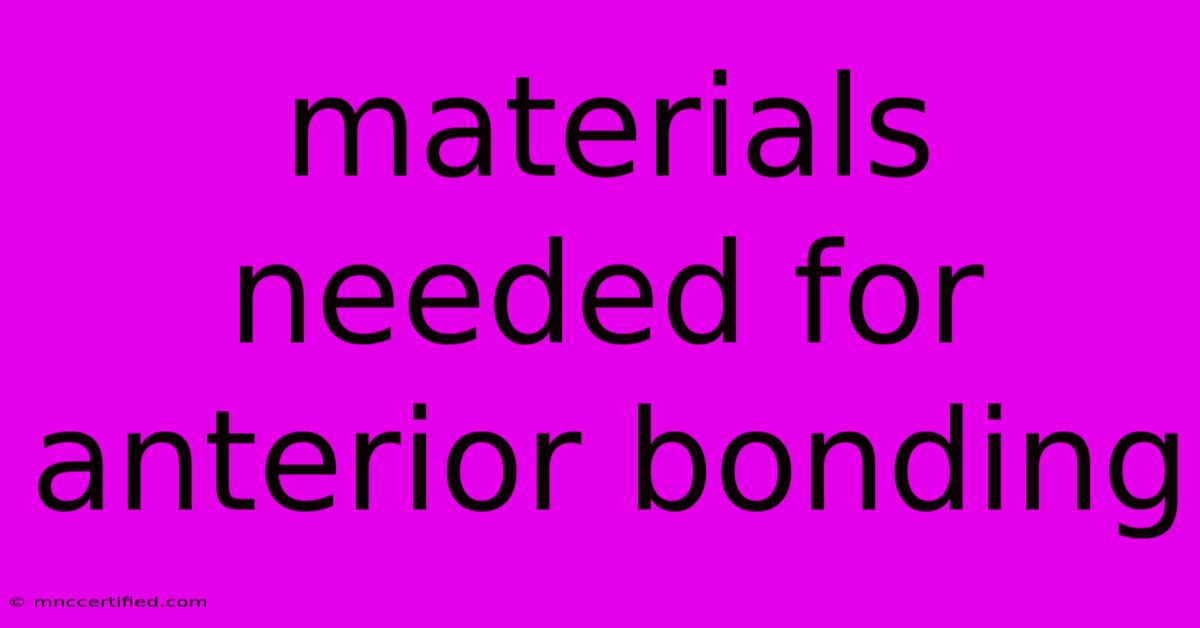Materials Needed For Anterior Bonding

Table of Contents
Everything You Need for a Successful Anterior Bonding Procedure
Anterior bonding, also known as direct composite bonding, is a popular and versatile dental procedure used to improve the aesthetics of your smile. It involves using tooth-colored composite resin to repair chipped, cracked, or discolored teeth, close gaps, or even reshape teeth for a more harmonious appearance.
If you're a dentist or dental hygienist looking to master this technique, or a patient interested in understanding what's involved, this article provides a comprehensive overview of the materials essential for anterior bonding.
Understanding the Materials
The success of anterior bonding relies on a careful selection of materials and a meticulous application technique. Here's a breakdown of the essential materials:
1. Etchant
- Purpose: Etchant is the first step in the bonding process, etching the enamel surface to create microscopic pores. This creates a roughened surface, allowing the bonding agent to adhere firmly.
- Types: Phosphoric acid is the most common etchant used in dentistry. It's available in various concentrations, typically 37% or 35%.
- Key Considerations:
- Concentration: The concentration of the etchant determines its etching strength. Higher concentrations etch faster but can also increase the risk of tooth sensitivity.
- Application time: Following the manufacturer's instructions regarding application time is crucial. Over-etching can weaken enamel, while under-etching may lead to poor bond strength.
2. Bonding Agent
- Purpose: The bonding agent acts as a bridge between the etched enamel and the composite resin. It creates a strong chemical bond, ensuring that the composite adheres securely to the tooth surface.
- Types: Bonding agents are available in different formulations, including single-component and two-component systems.
- Key Considerations:
- Adhesive properties: Look for bonding agents with excellent adhesive properties, minimizing the risk of debonding.
- Light curing: Most bonding agents require light curing to activate the polymerization process and solidify the bond.
3. Composite Resin
- Purpose: Composite resin is the primary material used in anterior bonding. It's available in a wide range of shades to match your natural tooth color, providing a natural-looking and aesthetically pleasing result.
- Types: There are different types of composite resins available, varying in their mechanical properties, translucency, and handling characteristics.
- Microfilled: Ideal for smooth surfaces and high polish.
- Hybrid: Offers a good balance of strength and polish.
- Nanofilled: Provides exceptional strength and durability.
- Key Considerations:
- Shade matching: Accurate shade matching is crucial to achieve a natural-looking result.
- Translucency: The translucency of the composite should match that of the natural tooth to create a seamless blend.
4. Dental Instruments
- Purpose: A variety of dental instruments are required to manipulate, shape, and polish the composite resin.
- Key Instruments:
- Bonding trays and applicators: For precise and controlled application of etchant and bonding agent.
- Composite placement instruments: These instruments are used to place, shape, and contour the composite resin.
- Finishing and polishing instruments: Used to smooth and polish the bonded surface to achieve a natural finish.
5. Light Curing Unit
- Purpose: A light curing unit emits a specific wavelength of light, activating the polymerization process of the composite resin and the bonding agent.
- Types: There are different types of light curing units, including halogen, LED, and plasma arc curing units.
- Key Considerations:
- Light intensity: A light curing unit with sufficient light intensity ensures complete polymerization of the composite resin.
- Curing time: Follow the manufacturer's recommended curing time to achieve optimal polymerization.
Beyond the Basics
While these materials are essential for a successful anterior bonding procedure, other materials may be used depending on the specific requirements of the case:
- Isolation System: A rubber dam or other isolation methods are essential to keep the working area dry and free from contamination.
- Tissue Retraction Cord: May be used to retract the gums to provide better access to the tooth surface.
- Matrix Bands: Used to create and maintain the desired shape of the composite during placement.
- Air Abrasion System: Can be used to remove tooth stains or prepare the tooth surface.
Choosing the Right Materials
The specific materials you choose will depend on several factors, including the patient's needs, the aesthetic goals, and your own personal preference. Consulting with other dentists, attending workshops, and staying up-to-date on the latest advances in dental materials is crucial for making informed decisions.
By carefully selecting and using the appropriate materials, you can achieve predictable and aesthetically pleasing results with anterior bonding, enhancing your patients' smiles and their confidence.

Thank you for visiting our website wich cover about Materials Needed For Anterior Bonding. We hope the information provided has been useful to you. Feel free to contact us if you have any questions or need further assistance. See you next time and dont miss to bookmark.
Featured Posts
-
Key Player Back Shaw Returns To Mumbai Squad
Nov 10, 2024
-
Charlotte Tilburys First Original Best
Nov 10, 2024
-
Mumbai Recalls Shaw After Ranji Trophy Cut
Nov 10, 2024
-
Minnesota Vs Rutgers Football Free Stream Today
Nov 10, 2024
-
Thunderbolts Gets Special D23 Brazil Spotlight
Nov 10, 2024